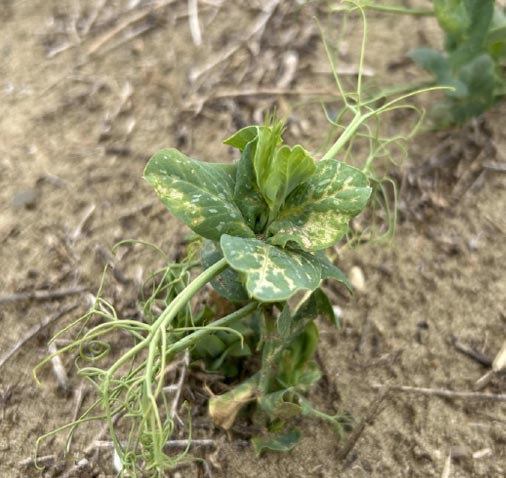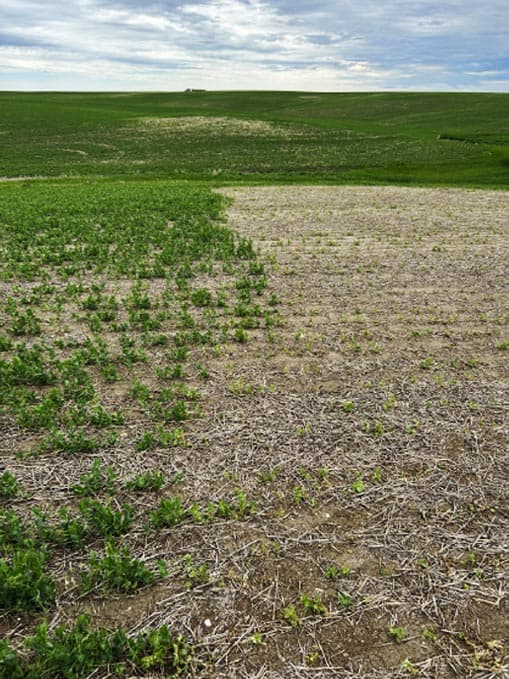Agronomy Update
Jun 11, 2024
Top Dressing Nitrogen in Wheat and Durum
Depending on seeding dates, we have had close to 4 inches of rain in some areas on this crop since it was put in the ground. That amount of rain can be both a positive and a negative, and in both cases the solution might be top dressing nitrogen. Rainfall onto early applied nitrogen which has been converted to nitrate by soil microbes can result in leaching, particularly on course soils. When this happens, seedlings are unable to access the nitrogen they need to maximize growth, and yield could suffer even if the plant is able to reach it later on in the season.With above average rainfall (see NDAWN map below) we have the capability to produce higher than average yields and insufficient nitrogen could also lead to low grain protein. Top dressing 100 lbs./ac of urea now, before the 5th leaf stage of wheat or durum, will give your crop the ability to produce up to another 10 or possibly even 15 bu./ac and reduce the risk of low protein. Most of our growers fertilized for about a 40-bushel yield goal this spring and with the start we have been given by Mother Nature, we could easily see yields of 50 plus bu./ac. If you initially applied 200 lbs./ac of urea and you top dress another 100 lbs./ac.; 300 lbs./ac of urea will give you 138 lbs./ac of nitrogen. It takes 2.5 lbs./ac of nitrogen to produce a bushel of wheat or durum so that will give you the ability to produce 55 bushels, mathematically.
Fertilizer is nowhere near 100% efficient, so there are no guarantees that your initial application will all still be available because of tie up, leaching or possibly even denitrification in your fields. You will also have some mineralization releasing soil nitrogen and hopefully the “nitrogen bank” in your soil was not completely empty at the start of the season. By making sure the crop has adequate nutrition we can produce some extraordinary yields with the environment we have been blessed with this year. The best way to offset lower commodity prices is to make extra bushels!
John Salvevold, Agronomy Division Manager, CCA


Diagnosing Herbicide Damage in Peas and Lentils
While the rain is a good thing, cool wet weather can lead to some injury with pre-emergence herbicides such as Sharpen and Spartan Charge in peas and lentils. The damage will be dependent on soil types and you will see more damage on sandy/course soils. Below is a picture of Spartan damage in a sandier area of a pea field. What you will normally see is stunting, yellowing on the foliage and some brown/dead tissue. Below ground the roots should look white and healthy. If the roots and lower stem are brown, then root rot might also be causing issues in that field. While no one wants to see damage on their crop, it should be able to grow out of this injury. If it doesn't then that ground might not be suitable for these products to be used in the spring and it will be even more important to have a strong Fall herbicide program ahead of peas and lentils. |
 |
We have been hearing a lot about using Metribuzin (Group 5) to control weeds in pulses from NDSU weed scientists, and while it would be great to get a different mode of action in our rotations, it is important to be cautious about this product. With the wrong soil and weather conditions, Metribuzin can cause significant crop injury even when applied in the fall (picture below). Fields with sandy soil, or sandy areas, high pH (high 7s +) and low organic matter (2% or less) are particularly susceptible.
 |
 |
If you have concerns reach out and we can conduct soil testing on fields going to peas and lentils and make sure we fully understand what kind of soil textures are present, the pH and organic matter. High levels of variability can occur in some fields: 2-6% organic matter and 5-8 pH. We can use our prescription mapping tools to predict which areas of field could be affected. Through our FarmQA program we can also help you keep track of your herbicide application history which is another important step to prevent herbicide injury in peas and lentils.
Root Rot Pathogens Detected
The National Agricultural Genotyping Center in Fargo has a new soil and root test available for three root rot pathogens that infect peas and lentils: Aphanomyces euteiches, Fusarium avenaceum and Fusarium oxysporum. The assay can determine both the presence and the quantity of the pathogen in the sample. I have been working with this lab to ground truth the assay and help understand what levels of root rot we can expect when these pathogens are detected or present at high levels in the soil ahead of planting peas and lentils.With the grant funds they had available, I tested pea and lentil fields this spring. All of the fields were positive for at least one of the Fusarium pathogens, but the levels varied and research is needed to determine what levels of Fusarium pathogens are concerning. Fusarium root rot can cause yield loss all on its own, but we are most concerned when both Fusarium and Aphanomyces are present. Some fields were positive for both Fusarium and Aphanomyces pathogens in the testing I conducted this spring and I want folks to be aware of that, because Aphanomyces in a field is a big red flag. Fields with this pathogen should not be planted to pea or lentil again for a minimum of six years, and potentially even longer because the spores produced by Aphanomyces can survive for 10-15 years even when a host is not present. A percentage of the spores will degrade each year, but several years are needed for enough of the spores to degrade that pea and lentil production is feasible. Unfortunately, once it becomes a problem in a field, complete eradication of this pathogen is unlikely but we can manage yield loss through long rotations and good agronomics.
Dr. Audrey Kalil, Agronomist/Outreach Coordinator
Horizon Resources' Most Unwanted:
Field bindweed (Convolvulus arvensis)— also known as, Creeping Jenny, Wild morning-glory (Morning glory Family)A native of Eurasia, this weed is a bane of pulse crop producers. The University of California IPM page is a great resource on field bindweed, and below is a summary of the information they provide on how to identify this weed and the traits that make it so difficult to manage. The cotyledons of the field bindweed seedling are square shaped with a notch at the tip and the first true leaves will have the characteristic arrow shaped leaf (left picture below). Seedlings may be confused with buckwheat and the cotyledon shape is a distinguishing feature (center picture below). Mature bindweed plants have arrowhead shaped leaves that are 0.5 to 2 inches long with leaves at the base of the stem longer than younger leaves at the end of the stem (right picture below). Plants are prostrate unless they begin to grow onto crop plants. The flowers are trumpet shaped and white to pink.
|
Bindweed
 |
Buckwheat
 |
Bindweed |
Field bindweed is a survivor, which is why it is one of the most difficult to control weeds in landscapes and crops. On average, each plant produces 550 seeds which, after they harden, can be viable for up to 60 years. Under drought conditions, field bindweed competes better than most other plants. This is due to its robust root system which can reach depths of up to 20 feet or more and total growth can reach up to 5 tons an acre. While drought may reduce its growth and seed production, it will still flower and set seed. Field bindweed also spreads through rhizomes. Tillage will not eradicate it and may just worsen the problem; whole plants can be produced from just 2 cm of rhizome or root. Using its extensive root system and rhizomes, a field bindweed plant can spread up to 10 feet in a growing season.
Sara Erickson, Agronomist
Broadleaf Herbicides in Field Pea
There are times when despite your best efforts with a well planned Fall burn downs and Spring residuals, the weeds still win, and you need a “Plan B” when it comes to broadleaf weed management in field peas. Let’s break down your options and talk through best practices to get the most out of the options you have available to you.Basagran & Basagran 5L (Bentazon) – Group 6 MOA
here is a love/hate relationship that happens with this chemistry. Sometimes you see awesome control, sometimes it looks like it did nothing. Here is what you need to know to make this product work better for you.
- It’s a photosystem inhibitor and needs heat and sunlight to work the best.
- It’s a contact only herbicide, water volume and coverage is crucial.
- Adjuvants are everything, MSO’s give it the highest activity. COC’s still provide activity and may be the right choice if conditions are conducive to injury.
Beyond Xtra (formally Raptor Herbicide) (Imazamox) – Group 2 MOA
This chemistry is more likely than Basagran to cause injury in field peas, but it has utility that Basagran does not have for certain weeds. It has very good grass weed control and is better on lanceleaf sage, pigweeds, and nightshade.
- With the Group 2 chemistry you get a little more systemic activity, and 10 GPA water carrier volumes are okay here for adequate control.
- Adjuvants are key again. If this product goes out solo, I recommend AMS + NIS. Class Act NG fits great here.
Varisto (Bentazon + Imazamox)
This is the most popular product in field peas, for multiple reasons. First, these two chemistries mildly antagonize each other which reduces the crop injury. Secondly, both chemistries complement each other in their weed spectrum, where one is weak the other is stronger.
- Water volume (15 GPA +), bright sunny days, and warm temperatures are preferable for the best results.
- Adjuvants are key here again, MSO’s are better than COC’s in the majority of cases. When using an MSO or COC, skip the AMS.
- If using the low rate (11 oz), you will need to add additional Basagran.
Here are the keys to keep crop response at a minimum when spraying any of these chemistries on field peas:
- Water volume: The higher the water volume rate, the less you will see crop response (picture below). The concentration of chemistry is lower per drop and the adverse effects of crop response are mitigated.
- Switching out MSO and using a COC: Use the Rule of 140. When temperature + humidity exceeds 140, use COC.
Kyle Okke, Crop Consultant, CCA

10 GPA |
15 GPA |
Ascochyta in Chickpea— Already?!
 Yes, I’m afraid so. Ascochyta blight was found in a chickpea field in Bowman County and on 2 farms in Circle, MT last week (picture to the right). This is a very aggressive disease and if symptoms are pre-sent a fungicide application is necessary even if the crop is at early vegetative growth stages. If you are growing chickpea this year please reach out. This is not a disease you want to get behind on.
Yes, I’m afraid so. Ascochyta blight was found in a chickpea field in Bowman County and on 2 farms in Circle, MT last week (picture to the right). This is a very aggressive disease and if symptoms are pre-sent a fungicide application is necessary even if the crop is at early vegetative growth stages. If you are growing chickpea this year please reach out. This is not a disease you want to get behind on.Dr. Audrey Kalil, Agronomist/Outreach Coordinator